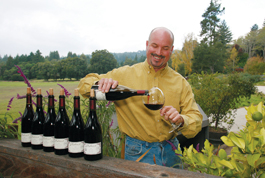home | metro santa cruz index | santa cruz county restaurants | review

Photograph by Carlie Statsky
Pour It On: Winemaker John Schumacher gets ready to sample one of Hallcrest's lauded pinot noirs.
Dining: Christina Waters is Back!
And she lets us eavesdrop on a conversation with award-winning winemaker John Schumacher of Hallcrest Vineyard.
By Christina Waters
The color of freshly polished garnets and fragrant with spiced plums, Hallcrest's 2004 Belle Farms Pinot Noir is a remarkable creation. The allure of this wine was apparent to most judges at the recent Santa Cruz Mountains Commercial Wine Competition, including me. The only pinot noir in the large field to score above 90 points, the wine won a gold medal from the Santa Cruz judges, as well as another gold at the San Francisco Chronicle Wine Competition. It was time to know more about this wine's odyssey from vineyard to award-winning bottle. Occupying an exceptional meadow overlooking the village of Felton, rustic Hallcrest Winery was once the vacation retreat of San Francisco attorney and wine-lover Chaffee Hall. Hall founded Hallcrest in 1941, planting vines of cabernet sauvignon and white Riesling that powered legendary vintages for two decades.
Twenty years ago UC-Davis oenologist John Schumacher and his wife Lorraine bought up the old estate and began to restore it to its former glory. In another bold entrepreneurial move, Schumacher quickly added a second, lucrative tier of wines under the Organic Wine Works label. The 20,000-case sulfite-free OWW brand allows Schumacher the freedom to create his Hallcrest line of estate-designated pinot noirs.
A high-energy package of vigor and wine jargon, Schumacher was happy to put my palate through some paces during a recent visit. Handing me a glass and grabbing a long glass wine thief, Schumacher scampered among French and American oak barrels, retrieving samples from the past four vintages of Belle Farms pinot noir—including the brand-new vintage of 2007, pressed, tanked and barrelled a mere two weeks earlier. "Glamorous grape juice," was how he described this recent harvest, truly an infant, but precocious enough to express true fruit character. "In 10 months it will hit an awkward stage. Like the terrible twos," he laughed.
The 2004 harvest occurred after a long hot summer, hence the fruit came in at optimum sugar levels. The exact time of harvest maximizes that delicate balance between fruit, which makes the wine taste beautiful and pinot noirish, and acid, which gives it the biochemical ammunition to age and develop. Lower yield also concentrates the fruit: the 2004 vintage from Belle Farms yielded a very select 166 cases.
Schumacher jokes that he recently solved the mystery of why so many of his wines win medals. "I checked on Google Earth and it's incredible—all those vineyards are exactly six and a half miles from the coast," he says. That includes Belle Farms, which lies above Gizdich Ranch in the foothills of Watsonville, where the fog leaves early in the morning and returns late in the day.
As sugars rise in the vineyard, acid begins to fall, and when the balance is struck, the harvest occurs with lightning speed. The grapes are trucked to the winery and pressed. The juice moves into huge steel tanks where yeasts trigger fermentation. After a week the juice is put into oak barrels (80 percent two-year-old French, 20 percent new American) to age and mature. Tannins will soften and the varietal character of the grape will deepen and complexify. The prized 2004 vintage remained in barrels for two full years.
"Yeasts add different characteristics and alter the speed of fermentation," Schumacher says. "They gobble up fructose and in turn they excrete volatile compounds." Those compounds, tempered by aging, yield the amazing aromas and flavors of the finished wine.
The 2006 Belle Farms, slumbering in oak, is clove spicy and has a slight metallic nose. It still has a year to go. "Barrel time will mature and soften that metallic flavor," I'm told. Each oak barrel holds 60 gallons, which translates into roughly 22 cases. Hallcrest's entire 2007 vintage will amount to no more than 3,500 cases.
A grey cat and two well-behaved dogs follow us from the cellar back up to the deck, where we move on to bottled vintages. The 2005 is filled with allspice. By comparison, the 2003 exudes berries, especially raspberry, and floral notes.
Over lunch, the remarkable 2004 Belle Farms vintage unpacks and shows its stuff. The initial strawberry leads to a center of black cherries and pink peppercorns. A rumor of cloves. The clarity of color is astonishing. Loaded with vitality, the 14.5 percent alcohol generates extreme persistence of aroma and varietal character. I salute Schumacher's light touch with the oak and inhale the bright fruit: the terroir of autumn.
Hallcrest 2004 Belle Farms Vineyard Pinot Noir, $35, is a spectacular choice for the holiday table. Visit the winery on Empire Grade Road, or call 831.335.4441.
Send a letter to the editor about this story.
|
|
|
|
|
|